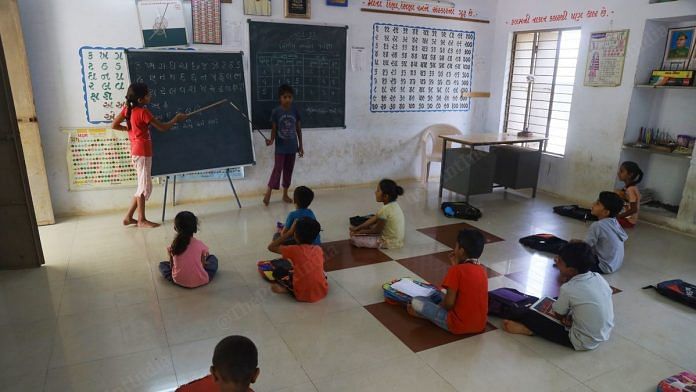Kachchh/Mahisagar: Under the guidance of two sincere teachers, a classroom full of children recites the Gujarati alphabet at the primary school in Angiya Nana village in Kachchh district. The problem is that the two ‘teachers’ are just Class 5 students. The cross-legged pupils, too, are not just from one grade but three — classes 1, 2, and 3.
Their actual teacher, Vijay Kumar Patel, 43, is not playing hooky. He’s simply got too many other things to do. He’s not only the designated teacher for every class in the school, but also the principal, administrator, and midday-meal supervisor.
“Sometimes, I take help from the bright students of Class 5 to teach the junior classes when I am finishing paperwork or checking their notebooks,” Patel told ThePrint.
His daily routine includes teaching students of classes 4 and 5 together, and then giving them some kind of chore before he heads over to teach a combined class of students from the first to third standards. When other work takes precedence, the students act as teachers.
This school in Angiya Nana village is not such an anomaly. It is one of at least 700 government primary schools across Gujarat that function under a single teacher. As many as 8,500 other primary schools are only marginally better off with two teachers.
While such schools may represent just a fraction of the 33,348 primary schools run by the Gujarat government, they provide a stark contrast to ‘success stories’ about the ‘Gujarat model’ of school education — such as the Vidya Samiksha Kendra (command and control centre for primary schools) that Prime Minister Modi urged other states to emulate earlier this month.
With assembly elections due later this year in Gujarat, the gaps in the state’s quality of school education have already become a major political issue.
The Aam Aadmi Party (AAP), for one, has gone hammer and tongs comparing Gujarat’s government schools unfavourably to its own lauded ‘Delhi model’. Earlier this month, Delhi Deputy Chief Minister Manish Sisodia tweeted about what he alleged was the poor state of government schools in Gujarat.
27 साल से गुजरात में सरकार चला रही भारतीय जनता पार्टी ने गुजरात के लोगों को कैसे सरकारी स्कूल दिए हैं, उसकी एक झलक ये देखिए.
गुजरात के शिक्षा मंत्री की विधानसभा भावनगर में आज मैंने दो स्कूलों का दौरा किया. pic.twitter.com/TdMlEWBg7F
— Manish Sisodia (@msisodia) April 11, 2022
The Congress, too, has criticised the state government over the fact that the last two years saw only 19 new government schools compared to 399 private ones, which generally charge higher fees and are not well-regulated.
Speaking to ThePrint, Gujarat Education Secretary Dr Vinod R. Rao said the government was trying to address these problems through its World Bank-aided Mission School of Excellence Project. Over the next five years, at an estimated cost of Rs 10,000 crore, this programme aspires to upgrade all government schools and improve the quality of education in the school.
However, the ground reality in many schools of rural Gujarat is currently far from the vision of high-tech classrooms and world-class education — and many have witnessed a decline only in the last two or three years.
ThePrint travelled to two mostly rural districts, Kachchh and Mahisagar, and visited six schools that are run by a single teacher, and three others managed by two, to see how primary education plays out in Gujarat’s more remote reaches.
Also Read: In India’s poorest district in UP, smart classes a small ray of hope for children’s future
No grade-appropriate learning, midday meals the highlight of school
Overwhelmed teachers, students ‘diverted’ to tasks other than studies, and facilities in disrepair were common features across the single-teacher schools that ThePrint visited.
In the sunny mid-morning of 21 April, a few young boys in school uniform were busy clearing overgrown plants on the premises of the Shree Shakti Nagar government prathmikshala (lower primary school) at Dhavda Nana village in Kachchh.
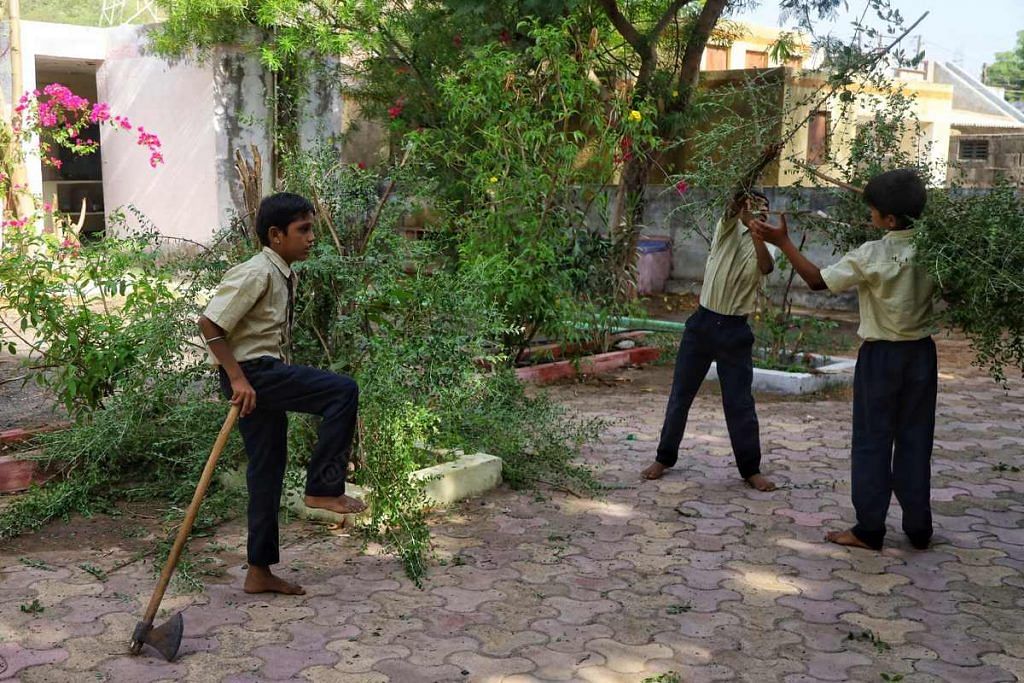
This was not some sort of community service exercise, but an attempt by the school’s sole teacher to keep the students occupied while he completed administrative work. The effort was only partially successful since many students were seen playing and running around the veranda and courtyard of the two-room school, which has 33 students in all, studying in classes 1 through 5.
The teacher-cum-principal, Rajesh Ratilal Padhariya, 48, said there is only so much he can handle alone.
“Since I am the principal, I have to do administrative work also. I give different tasks to students to keep them engaged otherwise they just play and make noise. Once my work is done, I go to the classroom and teach,” he said.
Just a few kilometres away is Angiya Nana. In the primary school of 41 students here, Class 5 students Gita Heerabhai Rabbari and Vanita Kayabhai Rabbari act as teaching assistants.
ThePrint observed them valiantly trying to keep a dozen younger children engaged with the Gujarati alphabet, while their own older classmates completed assignments given by their overextended teacher Vijay Kumar Patel, who has been running the school alone for a year after a second teacher took a transfer.
With handling administrative work, deciding the midday meal menu, and managing the needs of children across a range of ages, most teachers acknowledge that actual teaching can take a backseat.
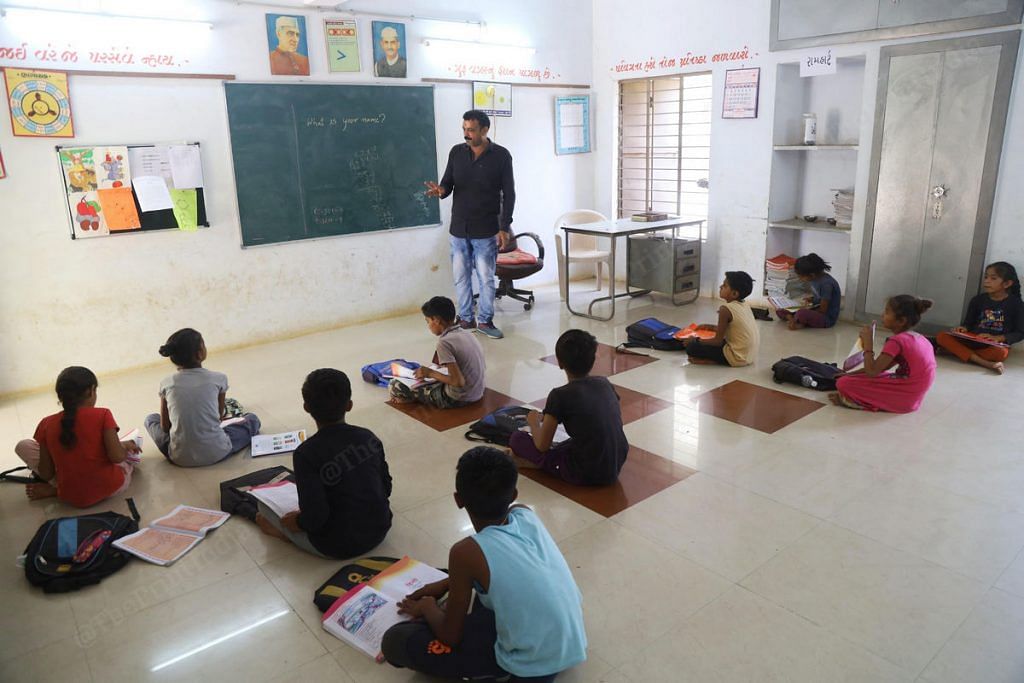
“It is difficult to manage children from classes 1 to 5 single-handedly. I know it’s affecting the children’s learning but I am helpless,” Mansinghbhai Ramjibhai Katara, the sole teacher at the Dungari Faliya Varg lower primary school at Simaliya village, Mahisagar, said.
The majority of children in this remote school are from the Bhil adivasi community and most come from very poor socio-economic backgrounds.
The biggest advantage of attending school for many of these students is the assured midday meal — which all the schools visited provided — rather than education.
An Education Department official who did not wish to be named admitted that single-teacher schools were essentially daycare centres where children could get a free meal.
“Grade-appropriate learning is not happening. Unless you have a critical number of 120 to 150 students, grade-appropriate learning does not happen,” he said.
It was much the same situation in the Dungari Faliya Varg primary school at Simaliya village, where 48 students are in the charge of Mansinghbhai Ramjibhai Katara, who has to teach classes 1 to 5 in the same room every day.
“When I am teaching Class 2 students, I give some assignments to the children in classes 3, 4, and 5. It’s difficult as all the children sit in this one room. The children in the smaller classroom get distracted all the time,” he said.
Katara, who draws a salary of Rs 90,000 per month, has been teaching in the school since 1991, when it opened.
Until two years ago, there were three teachers in the school. One retired and then another died due to Covid. “Since last year, I have been the only teacher here. I have brought it to the notice of my superiors also but I am yet to get another teacher,” he said.
Primary education comes under the jurisdiction of the district development officer (DDO) in Gujarat. However, Mahisagar’s DDO K.D. Lakhane refused to comment on the single-teacher schools here. “The district primary education officer is not in office. It is difficult for me to comment in his absence,” Lakhane said.
Poor attendance, gadgets in disrepair
Barring two schools, which had near full attendance, all the others that ThePrint visited bore a rather deserted look.
At the government lower primary school in Jadura village of Bhuj taluka, Kachchh, most students were missing when ThePrint reached there at 11.30am on 21 April. When asked where they were, the solo teacher Toufiq Mansoori said that, since it was marriage season, some students would arrive in the morning but then decamp to participate in festivities.
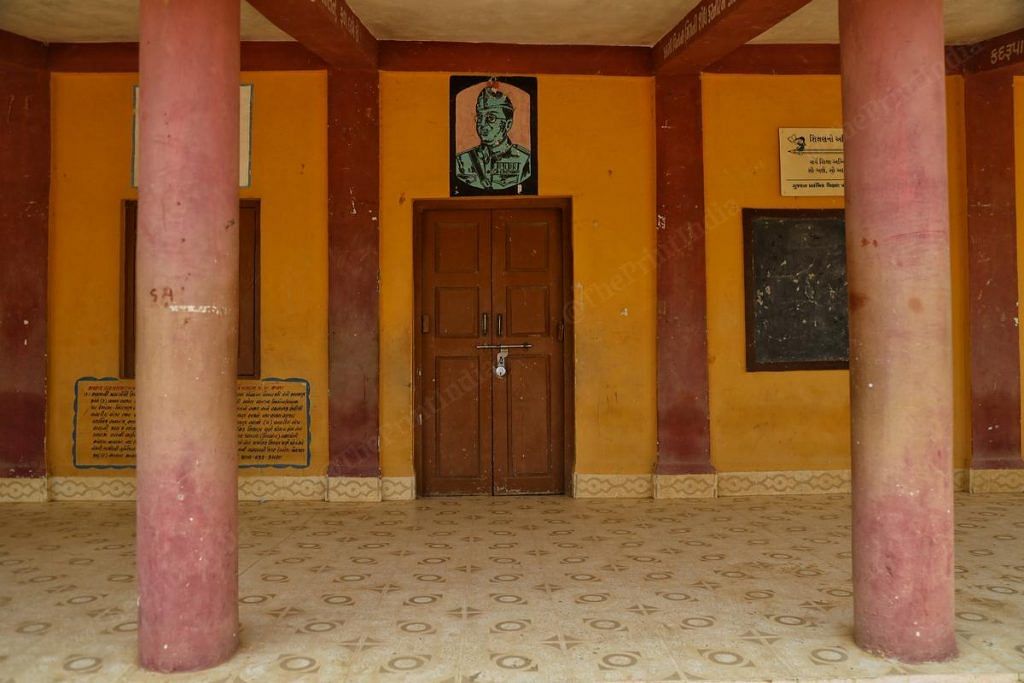
Being strict about attendance seems futile in single-teacher schools, and where the children come from extremely poor families. The single classroom in this school looks almost high-tech, with its six desktop computers, but Mansoori said they have never been used since there is no one to teach computers as a subject.
In keeping with the Gujarat government’s vision of ‘smart classrooms’ and the like, all the schools ThePrint visited had computers. But, barring one exception, these devices were gathering dust, unused in every school.
All the schools had a TV too, given to aid online learning, but these, too, were just taking up space.
The situation is not very different in the region’s two-teacher schools.
The Mena Varg-I government lower primary school at Batakwada village, Mahisagar district, is an example.
The school was set up in 1981 in the remote village, where the majority of the population comprises tribals. Here, there are two teachers, both 58: Moghajibhai Galabhai and Ushaben Arjunbhai Katara. Both technically retired on 31 March but have been given a two-month extension until the current academic session ends.
“A new teacher will be appointed once the new academic session begins in July. Both of us will teach till then,” Galabhai said.
Primary schools in Gujarat resumed in-person classes from the first week of February and will continue until summer vacations start on 7 May.
The Mena Varg school has 28 students, but far fewer were present when ThePrint visited on 25 April: One boy was sweeping the veranda and a handful of other children were idling while the teachers looked on from their plastic chairs in the courtyard.
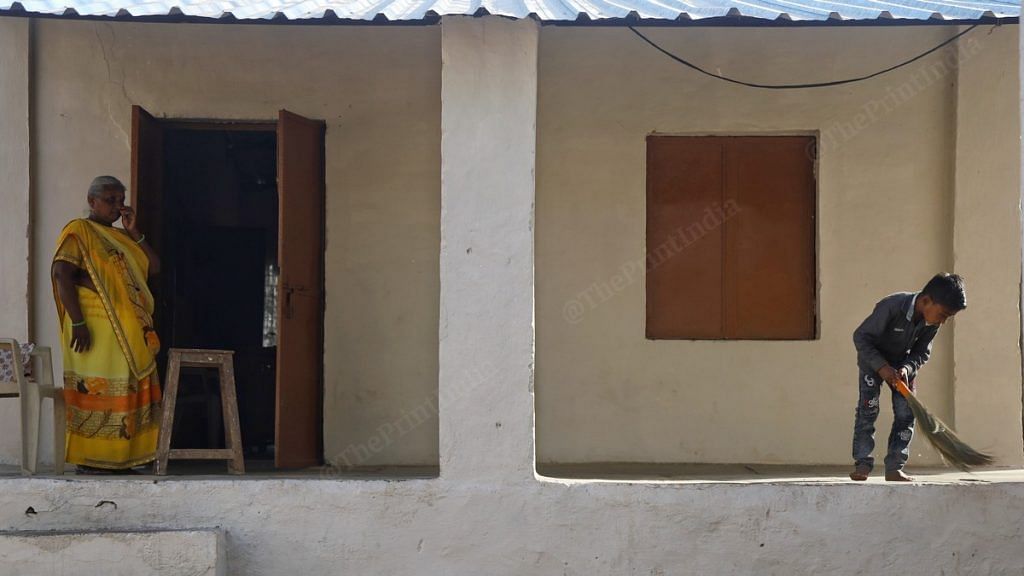
Galabhai, who has been teaching in the school since 2004, told ThePrint that most children had left to attend a wedding function in the village.
Inside one of the two classrooms, which also doubles as Galabhai’s office, there are two wooden tables, three almirahs, a blackboard, a stack of steel plates, and three gas cylinders that are used to cook midday meals. Two dusty computers and a TV sit forlornly on a rickety bench. None of them is in working condition.
“The TV was working till two years back, when somebody stole the dish antenna. Since then it’s just lying like this,” Galabhai said. A villager might have stolen it, he added, but said there was “no point” in filing a complaint.
While Ushaben teaches up to Class 3, Galabhai is in charge of classes 4 and 5. “We teach them Gujarati, Hindi, English, Sanskrit, maths, and environment science,” Galabhai, whose monthly salary is Rs 75,000, said.
When ThePrint asked one of the six students sitting outside the classroom about what she’d learned in class, she was unable to understand Hindi. “The children take time to grasp,” Galabhai said.
At the Dungari Faliya Varg primary school at Simaliya village, too, students said they have not used the computers in school even once. Most of the kids could not comprehend any other language except Gujarati.
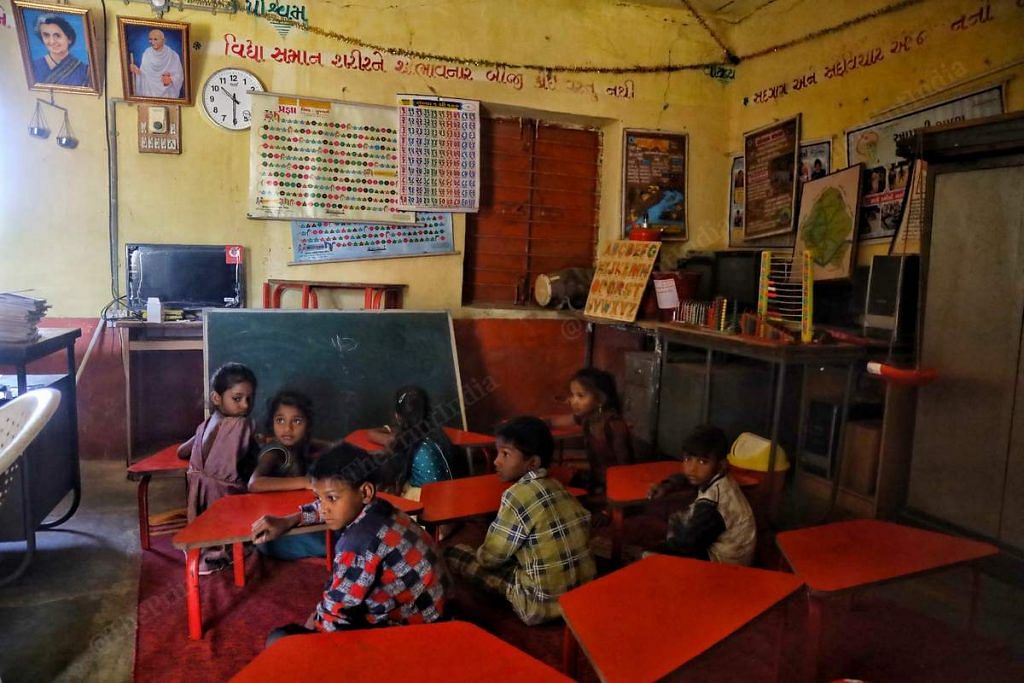
Single-teacher schools ‘increased in last 2 or 3 years’
Single-teacher schools are a relatively new phenomenon, according to teachers as well as Education Department officials.
“The trend of schools run by a single teacher has grown in the last two or three years,” an Education Department official, who did not wish to be named, said. “While many teachers retired or took transfers and went to their home districts, no recruitment happened to fill the vacancies.”
In Kachchh, for instance, some 200 teachers got transferred from remote villages to towns while another 200 sought transfers outside the district in the last two or three years, officials said.
“Recruitment of 810 temporary teachers at a salary of Rs 10,500 was approved in Kachchh. But in remote areas, we did not get trained teachers. So, only 50 per cent of the vacancies could be filled, resulting in a spurt in single-teacher-run schools,” a government official in Kachchh district said.
According to Nilesh Gor, the Kachchh district’s primary education officer, many schools ended up with a single teacher because of a spate of transfers and retirements, but new recruitments were in process.
“In Kachchh, 355 teachers are being recruited. Their appointment will happen next month,” he told ThePrint.
The state Education Department official quoted earlier added that, across Gujarat, the process to recruit 3,300 teachers has started. “They will be appointed once the new session starts,” the official said.
Another factor leading to single-teacher schools was what Gor calls the “school merger policy” in cases of low student strength.
Some primary schools earlier catered to students up to classes 6 and 7, but, because of the low numbers of children, these classes were shifted to nearby schools that had more students and teachers.
Gor added that primary schools are run according to RTE (Right to Education) rules, which mandate that there should be one teacher for 30 students.
“As per the school merger policy, a primary school gets approval for starting Class 6 only if there are a minimum of 20 students in the class. Else it will be merged,” he said.
Around 90 government primary schools have been closed by the Gujarat government and another 500 of them merged since 2020 as part of its school merger policy.
Rajesh Railal Padhariya, 48, principal-cum-teacher at the Shree Shakti Nagar prathmikshala in Kachchh attests that the situation was not always like this.
Recalling that the school was destroyed in the 2001 earthquake and then reconstructed and inaugurated by then education minister Anandiben Patel a year later, he said it accommodated 70 students up to Class 8 back then and had four teachers.
With time, however, the number of students dwindled. “Children here are mostly from poor backgrounds. Many parents left the area as there was no source of income here,” he said.
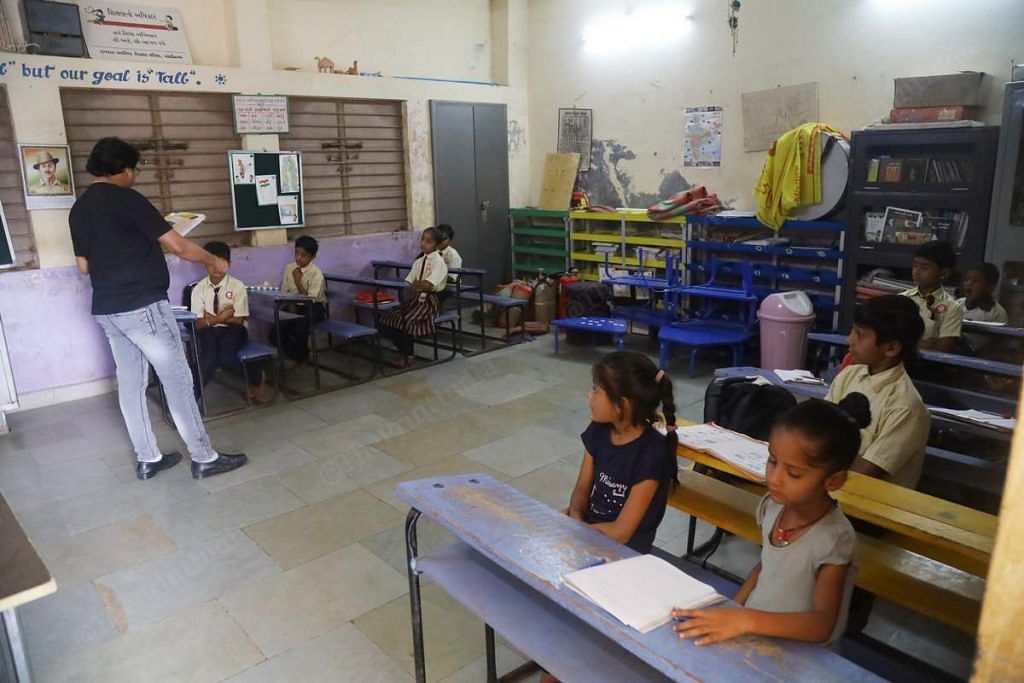
In 2021, as the number of children in classes 6 and 7 dropped, these grades were shifted to the bigger primary school nearby. “The two teachers who were teaching these classes were transferred to other schools. One teacher died during Covid last October. Since then, it’s just been me,” Padhariya said.
However, even as government-run primary schools continue to struggle, the private school industry has mushroomed. Even in remote and tribal districts like Kachchh and Mahisagar, hundreds of private schools have opened up in the last few years. The high fees in private schools have now become a source of criticism from Opposition parties.
What is the government doing?
The ‘Gujarat model’ of education has garnered somewhat fewer accolades than the reported industrial and agricultural advances in the state.
The government’s own assessment of learning outcomes in primary schools, called Gunotsav 2.0, carried out by the state Education Department between 2019 and 2021, found only 14 of 30,681 schools scoring A+, indicating improved learning outcomes.
To address problems in primary education, the state government in 2019 set up a real-time surveillance system of sorts via GPS-enabled tablets. This was done mostly to “keep an eye” on the problems of absenteeism and “non-seriousness” among teachers.
If things on the GPS looked a little awry, officials at the command-and-control centre (Vidya Samiksha Kendra) in Gandhinagar could call up teachers at any time for an update on their location and activities.
This system received a further boost last year with the unveiling of the Vidya Samiksha Kendra 2.0 that is intended to track attendance, enrolment, and learning outcomes in 55,000 primary and secondary government schools.
“We have set up the Vidya Samiksha Kendra from where we can assess the performance of each and every government primary school across the state,” Gujarat Education Secretary Vinod R. Rao said.
Rao pointed out that Prime Minister Modi had been highly impressed by the centre during his visit this month. “The PM has called it a model for the country and a wonder for the world to see how technology can improve the lives of millions of students,” he said.
Sharing some glimpses from my visit to the Vidya Samiksha Kendra in Gandhinagar. It is commendable how technology is being leveraged to ensure a more vibrant education sector in Gujarat. This will tremendously benefit the youth of Gujarat. pic.twitter.com/ezRueOdfjq
— Narendra Modi (@narendramodi) April 18, 2022
In all the schools ThePrint visited, the teachers were regular in marking their attendance online. But there was no real-time surveillance happening to find out how classes are being conducted in these single-teacher schools, or why there was such high absenteeism.
Rao emphasised, however, that big changes were afoot.
In the first week of April, it was announced that the World Bank and Asian Infrastructure Investment Bank (AIIB) approved a loan of Rs 7,500 crore for the ambitious Mission School of Excellence project.
Rao said that, through this initiative, the government was trying to address the issue of small schools and to ensure that grade-appropriate learning took place. “On the ground, work has started on the Mission School of Excellence project,” he added.
If all goes to plan, this project will cover all 35,133 government and 5,847 grant-in-aid schools in Gujarat and will see the creation of 1.5 lakh “smart classrooms” and 20,000 new computer labs, among other things.
(Edited by Asavari Singh)
Also Read: 20 hours a week, no homework: That’s the Finland school system RSS chief wants in India


